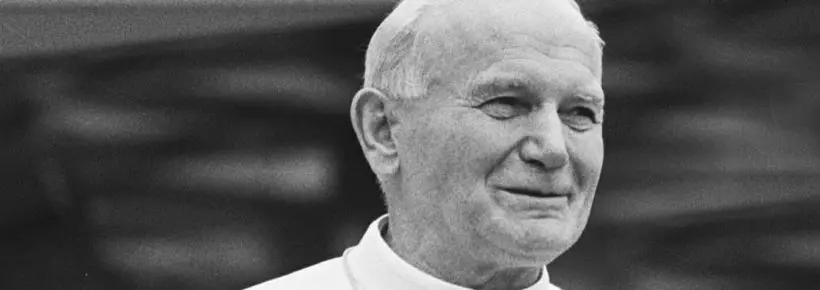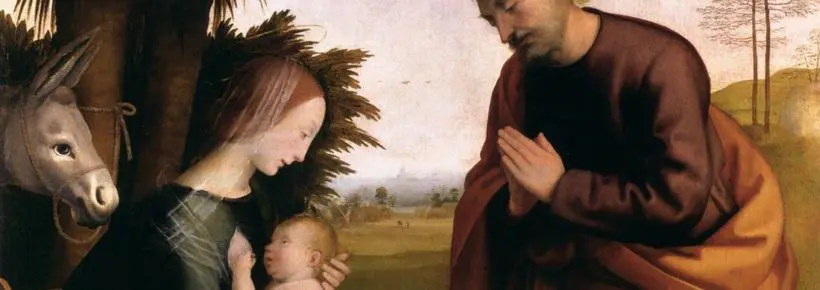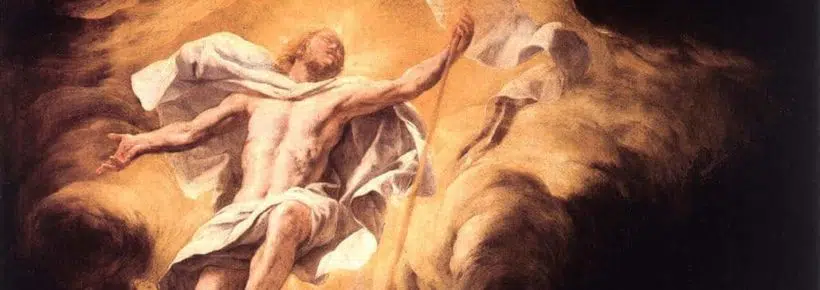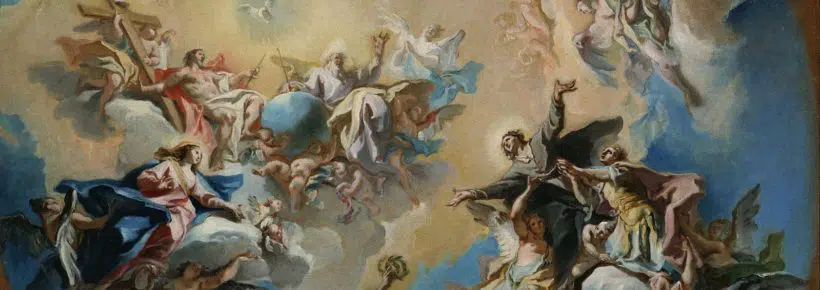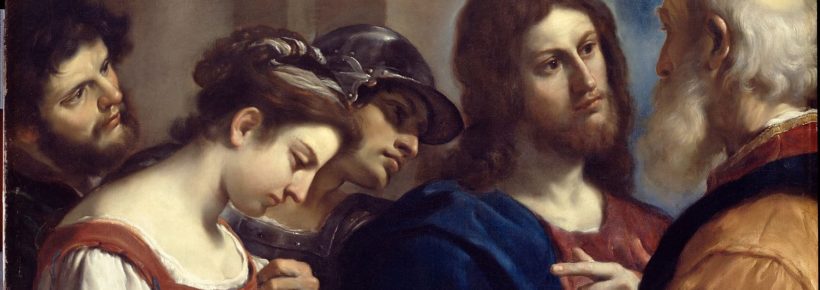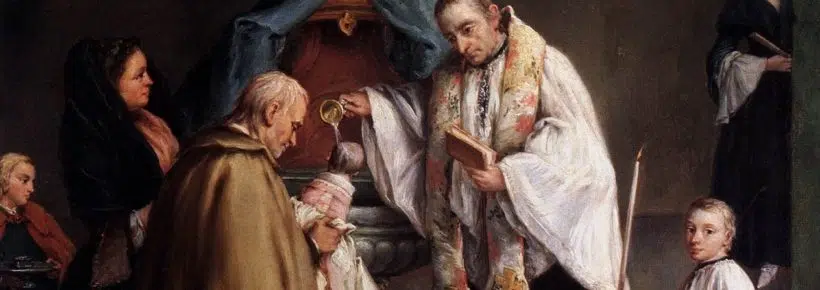Previous articles in this series:
Next articles in this series:
- Purity of Heart
- Resurrection of the Body
- Christian Virginity and Celibacy for the Kingdom of God
- The Sacrament of Marriage
- Love and Fertility
In our previous two articles, we laid the foundation for our discussion of the catechesis of the Holy Father on the theology of the body.
The main topics we will be addressing in this article are:
- What is “the beginning”?
- The original man and the original woman
- The original solitude of man
- The self-discovery of man as a human person
- The creation of the original woman
- Man and woman as husband and wife since the beginning
- The original nakedness without shame
- Original sin and its effects
- The concept of shame as an indication of original sin
1. What is “the beginning”?
A cornerstone of the theology of the body is an understanding of the state of man and woman “in the beginning.”
The catechesis of the theology of the body begin with a reflection on Matthew 19:3-6 (see also Mk 10:2-9). More concretely, it is a reflection on the deep roots of the family, which is the profound relationship that must exist between man and woman in Christian marriage.
And Pharisees came up to him and tested him by asking, “Is it lawful to divorce one’s wife for any cause?” He answered, “Have you not read that from the beginning he made them male and female [Genesis 1:27], and said, ‘For this reason a man shall leave his father and mother and be joined to his wife, and the two shall become one? [Genesis 2:24] So they are no longer two but one. What therefore God has joined together, let no man put asunder.'”
Christ does not accept the level in which the Pharisees want to keep the debate, which is the level of legal arguments of different Jewish rabbinical schools: some argued that divorce was permitted in such and such a case, others in other cases, and so forth. He wants to raise the discussion to the highest level: the original unity between man and woman, which was made one and indissoluble by God Himself.
That is why Jesus refers his listeners to the “beginning.” The beginning is the time before the advent of original sin. It is the epoch of the original unity between man and woman in marriage. It is the time when they were in their original innocence. In that state man and woman perfectly understood and joyfully accepted God’s institution of marriage and the laws He had given to it, including its original unity and indissolubility.
Christ wants to recover this original unity and indissolubility of marriage that existed in the “beginning.” He wants to make it the standard norm once again of marriage, in which divorce has no place. Even though original innocence was lost forever in this life because of original sin, there is a line of continuity between original innocence and the present state of fallenness. This line of continuity is provided by Christ because He offers redemption to sinful man, including the redemption of his body.
2. What is the view of St. John Paul II of the original man and the original woman?
This is a topic whose profound meaning will unfold itself in the rest of the catechesis of this cycle. The main point is that the original unity and indissolubility of marriage is inscribed in the very being of the original man and the original woman.
Man and woman are the climax of God’s creation. In Genesis 1, every time God finishes a part of His creation, the inspired author says: “And God saw that it was good”. But when He creates man and woman, the sacred author says: “God saw everything that He had made, and behold, it was very good” (Genesis 1:31).
Furthermore, “God created man in his own image, in the image of God He created him; male and female He created them”. (Genesis 1:27.) This image of God in man and woman means that both have a special dignity. It also means that both have a unique and special relationship with God. It also means that human beings cannot be reduced to their material dimension. There is something in man and woman that transcends material creation.
The profound meaning of this image of God in the human person will continue to unfold as we progress in our reflections.
3. What is the original solitude of man?
In Genesis 2:18, God says: “It is not good that the man should be alone.” This is the original solitude of man.
The original solitude is a double solitude. Man feels alone, not only because he lacks a woman to be with, but also because he has nobody to relate to. This latter solitude originates in the very nature of the human person. In other words, human beings are relational beings in their very constitution as human beings. They have been created to enter into a meaningful interpersonal relationship with God and with other human beings.
That is also part of what it means to have been created in the image of God. God Himself is a Community of Divine Persons (each of Whom possesses the One Divinity in its entirety). Our God is not a lonely God, but one God in Three Persons Who are constantly communicating Love to each other.
In the next verses after Genesis 2:18 God brought the animals He had created before man for him to name them (see Genesis 2:19-20). This naming process reveals two things to the man himself:
- Man is superior to the animals. This is something which corresponds to Genesis 1:28, where God commands man and woman to “have dominion over…every living thing” (it is not a destructive dominion, but one of stewardship).
- Man also discovers that there is no other bodily living being to relate to; no other living material being corresponds to his level of being. In other words, he discovers that he is alone.
The whole process is a kind of “test” God puts the man through. It is not a test that the original man must pass. It is a process by means of which the original man discovers who he is. He gradually begins to discover his own humanity, his own personhood, and his own subjectivity. This latter characteristic refers to the fact that the human person possesses an interiority, a spiritual and moral dimension that no animal possesses.
Man is somebody and not something. He discovers that he has a special and unique relationship with God.
4. How exactly does the original man discover his personal nature?
In previous articles we have emphasized that the human person is a unity of body and soul. So profound is this unity that we can say that the body expresses the soul and the person himself. It is through his own body that this primitive and original man gradually discovers or intuits who he is.
It is significant that immediately after God created man, He put man to work in the garden of Eden (see Genesis 2:15). The experience of tilling and keeping the Garden also taught the original man about himself. His unique hands and their corresponding skills, for example, showed the man that he was different and superior to the rest of material creation.
Then came the experience of naming the animals that we have already reflected on. This latter experience increased man’s self-discovery significantly, because it made him ready to break his solitude by means of his encounter with the first woman.
5. How was the original woman created?
Genesis 2:21 says that “the Lord God caused a deep sleep to fall upon the man.”
It is important to understand that the “deep sleep” means a total knockout. This indicates that the creation of the woman was a completely unilateral act on the part of God. In other words, the original man did not consciously contribute anything to the creation of the original woman – a human being in her own right. (The rib God took from the man to make the woman merely indicates that the woman possesses the same human nature as the man.)
The state of unconsciousness of the first man also points to the fact that the appearance of the first woman was decidedly necessary for God’s plan of salvation.
The first man awakes and sees the woman for the first time
Genesis 2:23 says that upon seeing the woman, the man said: “This at last is bone of my bones and flesh of my flesh.”
The expression again accentuates that the woman, even though her body was different from his, was as human as he was. He realized that the first woman shared his same nature, that her body, like his, expressed a soul, expressed a human person.
The original man also discovered that the first woman, unlike the animals, was indeed “a helper fit for him” (see again Genesis 2:20). The Hebrew term that is translated as a “helper fit for him” actually means “complementarity.” The first man discovered that the first woman complemented him, and the first woman also understood that the first man complemented her.
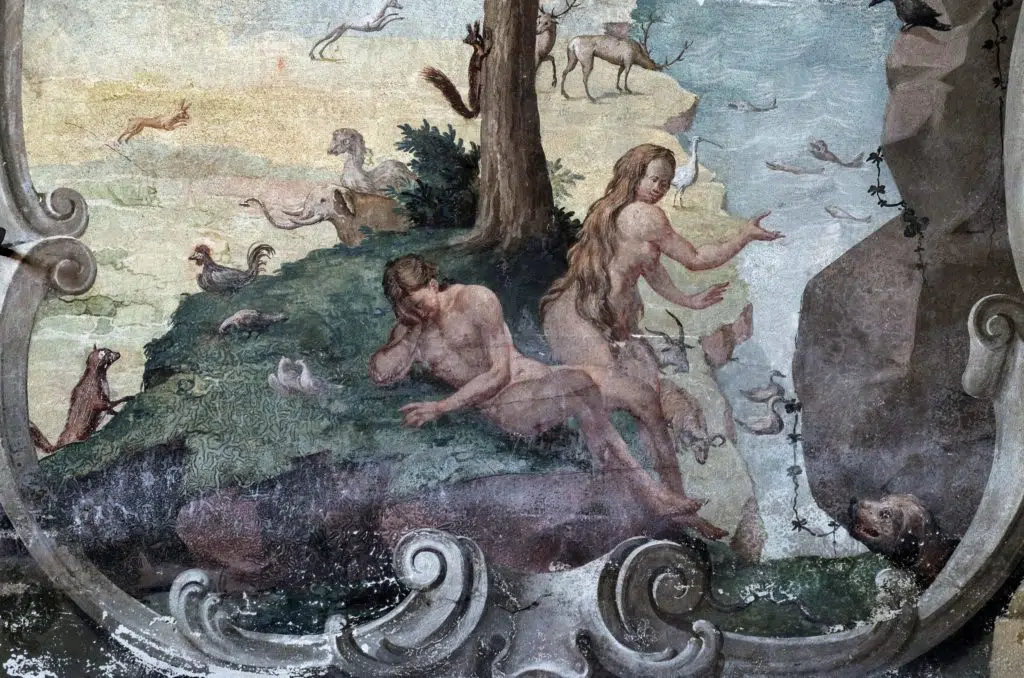
Fresco on the ceiling of the Saint John the Baptist church in Zagreb, Croatia
This mutual complementarity is unique in God’s creation of the human person. It expresses the fact that the first man and the first woman were created in a state of marriage. God is the author of the institution of marriage, which is anterior to the state and society. Neither the state nor society can redefine natural marriage, but they have the grave duty to respect it and protect if. We call it natural marriage because it belongs to the natural order created by God.
6. How can we know that indeed the first man and the first woman constituted the first marriage?
The very next verse affirms it. Genesis 2:24 says: “Therefore a man leaves his father and his mother and clings to his wife, and they become one flesh.”
This original unity between man and woman was an interpersonal communion. It was the first human community in the world and in history.
The original unity was founded on the mutual and free consent of the man and the woman. Both are distinct human beings. Both have a mature understanding of the conjugal meaning of the body, the capacity God has inscribed in the human body to express love.
But man and woman are also God’s gift to each other. Therefore, in the man-woman encounter the man gives himself to the woman as a gift of God to her and at the same time welcomes her as God’s gift to him. Similarly, the woman gives herself to man as God’s gift to him and welcomes man as God’s gift to her. Man and woman treat each other as gifts from God, as ends in themselves, and not as means or objects to be used, but to be loved in themselves, gratuitously as God loves.
Furthermore, as the man gives himself to the woman, he affirms the femininity of the woman, and his own masculinity. Likewise, the woman affirms man’s masculinity and her own femininity. They reaffirm each other as human persons and as male and female.
St. John Paul II speaks about the “freedom of the gift.” What does that mean?
This dynamic of the gift of man and woman introduces another reality that deepens the concept of love. Love is self-gift, the giving of oneself to others as a gift from God. But to be able to do this, the person must be free from selfishness and free to love as God does. This is the dynamic of the gift.
God has imprinted in all of creation this dynamic of the gift, and especially in marriage and in the consecrated life. We shall explore these latter topics in cycles four and five of these catechesis.
The original unity of man and woman was so powerful that it expressed the image of God in the human person more vividly than man and woman could do individually. There is no doubt that each person has been created in the image of God. But this image comes across more clearly in the communion of persons. Marriage is that first and original communion of persons.
However, the conjugal meaning of the body has another aspect that is intrinsic to the conjugal love it is meant to express: namely, the capacity to cooperate with God in the creation of new life. Love is the essence of marriage. But that love is of itself always open to life. A love devoid of this openness is no love at all. (Married couples who through no fault of their own are infertile still possess a love open to life because it is in their will, in their intention.)
When married couples procreate children, they form a family. The communion of persons has been expanded, and so has their capacity to express the image of the Triune God. Therefore, the family can be rightly called an image or icon of the Blessed Trinity. This is the most profound identity of the family because it is related directly to God, it derives its meaning from Him.
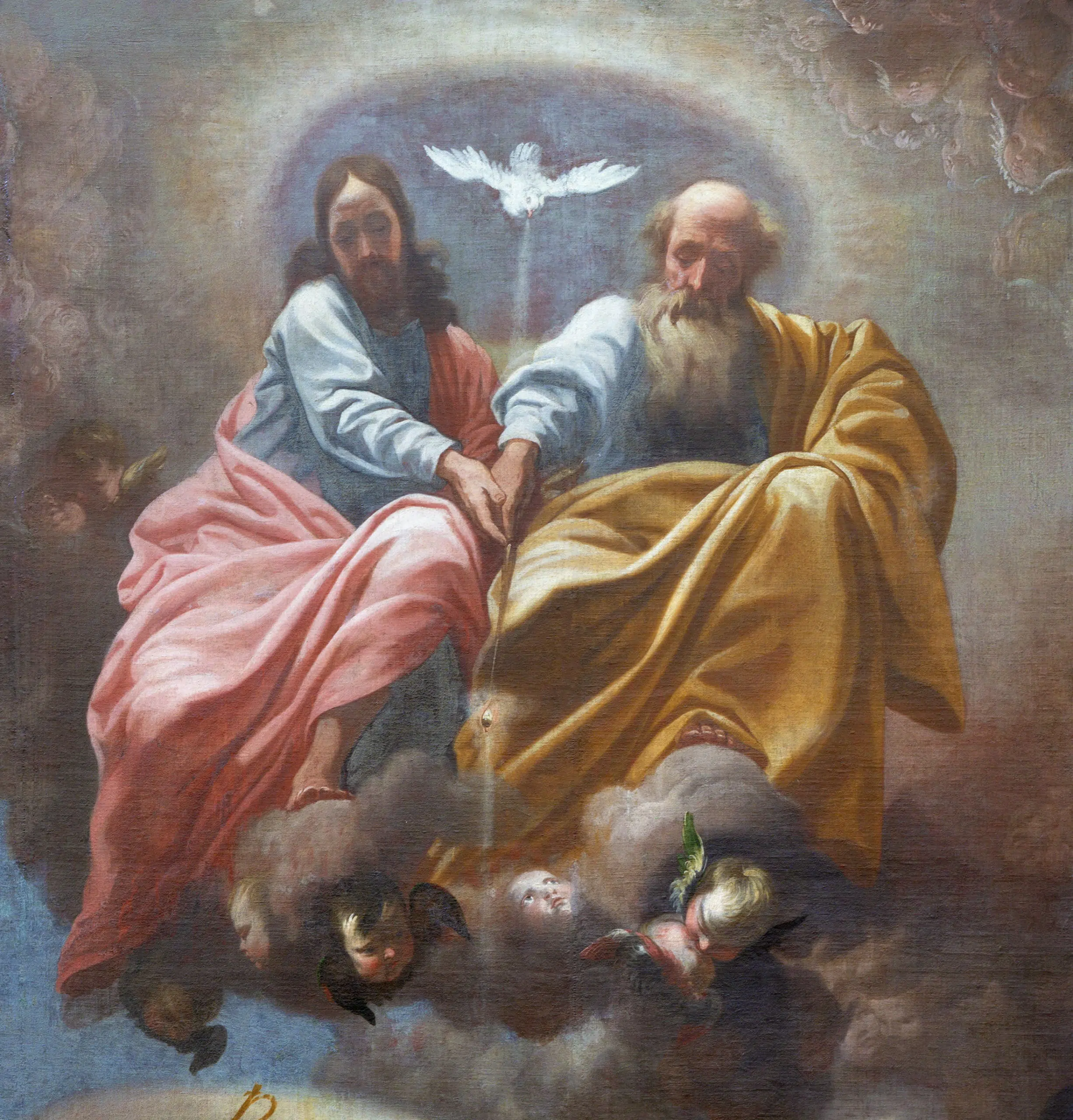
Baroque painting of the Holy Trinity in Prague’s Kostel svatého Tomáše by Karel Škréta (1610 – 1674)
7. What is the original nakedness?
Genesis 2:25 says: “And the man and his wife were both naked and were not ashamed.”
This is a very important biblical statement. The situation takes place in the state of original innocence, the phase in human history that belongs to the “beginning.”
Man and woman were not affected by selfishness, because original sin had not happened yet. Therefore, they saw each other with perfect purity. They saw each other as gifts of God, es ends in themselves, as persons, not as objects of selfish pleasure. They were not ashamed of being naked.
This absence of shame does not mean that they did not care about sexual morality. On the contrary, the absence of shame does not indicate a limitation, but a fullness of an interior purity of vision. Such a purity of vision was possible because man and woman shared in the purity of vision of God Himself Who always looks at creation with the infinite purity of His divine heart. This does not mean that God does not care about sin. He does, but it is precisely always against the background of His pure way of looking at His creation.
In their original innocence, the bodies of man and woman were transparent in the sense that they were visible signs of personhood, and of love as gift of self. This transparency permitted the discovery of the human person with all his God-given dignity as man and woman looked at each other with love and respect. It also made possible the fullness of intimacy in their interpersonal communion. In addition, such transparency indicated that man and woman understood fully the conjugal meaning of the body, the capacity God has inscribed in the human body to be a sign and a physical expression of His invisible love for His creation.
8. What was the original sin man and woman committed?
The act of original sin (Genesis 3 and following) is symbolized by means of the forbidden fruit of “the tree of the knowledge of good and evil” (Genesis 2:16-17). Enticed by the Devil (symbolized by the serpent) “to be like God” (Genesis 3:5), the first man and the first woman ate of this fruit (Genesis 3:6-7).
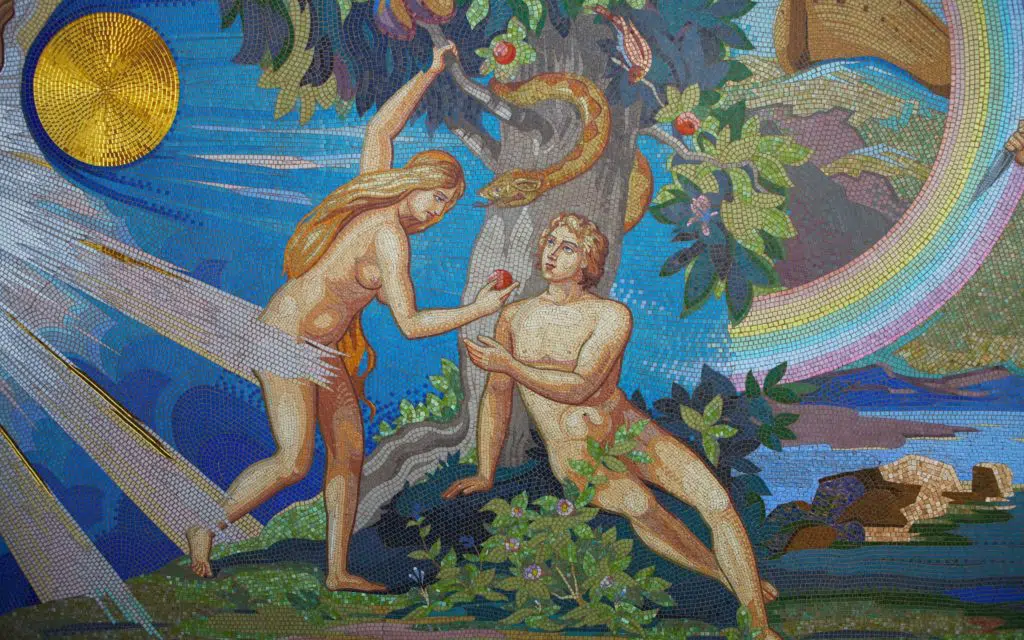
Mosaic from an Orthodox church in Kirowograd, Ukraine
This was a very serious sin because it consisted in the attempt to replace God, the sin of pride. God does want man and woman to be like Him. He created them in His image so that they would manifest that divine image not only in their being, but also in their acting. But attempting to replace God is another matter.
The symbolism here is very powerful. The mysterious tree is not an arbitrary trap placed by God in the middle of the Garden – a Garden which symbolized the original state of happiness and harmony between man and woman and between them and creation. Rather, the tree and its fruit symbolize the limit of man’s freedom.
Man is a creature. He does express the image of an infinitely free and creative God. But precisely because he is not God, his freedom to express himself and to create must reflect the character of God. Eating the forbidden fruit expresses man’s futile attempt to become a god, to invent his own destiny and way of acting, his own rules, his own morality. He began to wrongly think that his conscience was the source of what is good and of what is evil. But it is God who determines what is good and what is evil, and conscience is to be the witness of God’s moral standards (see Romans 2:14-16).
For a more complete teaching on original sin and its effects, consult the Catechism of the Catholic Church, nos. 385-421.
What was the effect of original sin on man and woman?
Original sin had a disastrous and far-reaching effect on man, woman, and the rest of creation. Man and woman lost the original state of grace and justice (holiness). They became separated from God. Their human nature was severely wounded (not destroyed). Their intellects became prone to error, their wills became weak in avoiding sin and pursuing what is good, and their bodies became vulnerable to sickness and death, just as God had forewarned them (see Genesis 2:17).
Original sin was committed by the soul, which made it rebellious to the Holy Spirit. Because of this rebelliousness of the soul, the body became rebellious against the soul. It no longer wanted to summit freely and joyfully to the soul, just as the soul no longer wanted to summit freely and joyfully to the Holy Spirit. Original sin caused a moral rupture within the human person himself. The human person continues to be a substantial unity of body and soul, but in the dimension of morality, that is, in the dimension of loving God and neighbor, the human person experiences in his soul a “pull” from the body and a “pull” away from God’s law.
It is in this moral sense that the human person experiences a division within himself. In his innermost being he feels a kind of echo and nostalgia for the goodness of God’s law and the conjugal meaning of the body, but at the same time he feels a “pull” from his body and soul away from God’s law. This dramatic battle in the innermost being of man is narrated very vividly by St. Paul in Romans 7:13-25.
Also, as a result of original sin, man and woman began to distrust and fear God and one another. This is why they tried to hide from God (see Genesis 3:8). They began to be ashamed in the presence of one and another (see Genesis 3:7). Selfishness replaced authentic love. We call this selfishness “concupiscence,” which, even though it is not in itself and act of sin, is the result of original sin and inclines us to sin.
9. What is shame and does it have any redeeming value?
As a result of original sin, shame entered this pathetic scene, and together with concupiscence distorted the consciousness of the conjugal meaning of the body; indeed, it distorted the consciousness of the personal meaning of the body. From now on man and woman began to feel inclined to see and treat the body as an object, rather than a subject, that is, the physical expression and sign of the soul and of the human person.
Shame was a powerful indicator that something very wrong had happened. It became the powerful indicator that original sin was committed.
Shame is the fear that men and women experience before the possibility that others might violate their intimacy, that others might treat them as objects, and not as persons. Ironically, this shame-fear has a positive side.
Recall that original sin did not destroy (although it severely wounded) human nature. Man and woman can still perceive what is truly good and act upon it, although not without a lot effort and not without the hidden grace of God. With a right attitude, man and woman can turn this fear into modesty. This healthy fear helps man and woman to keep a respectful distance. But at the same time, it helps them to relate with respect towards one another, not only in the context of marriage, but in other aspects of life, such as the workplace, social gatherings, and so forth.
Conclusion
How does Saint John Paul II end this first cycle of his catechesis?
We should not be surprised that Christian doctrine considers God’s revelation about the human body as something of great importance. The Bible says: “And the Word became flesh and dwelt among us” (John 1:14). This is the Incarnation, a key doctrine of Christianity. Therefore, we can say that the theology of the body “has entered through the main door.”
Christians often ask questions about marriage and procreation; the majority of Christians have chosen marriage and the family as their vocation. In this context, the teaching of the encyclical Humanae Vitae is of crucial importance. This document was written by Pope Paul VI and published on July 25, 1968. It cast in more personalistic terms the 2000-year-old teaching of the Church against contraception, sterilization, and abortion, as well as Her beautiful teaching on marriage and the transmission of human life. The theology of the body is a huge commentary on this prophetic encyclical.
Articles to Come…
Before we enter into an analysis of Humanae Vitae, we must address first in the next cycle the teaching of Christ in the Sermon of the Mount (Matthew 5-7) about the purity of the heart, then in cycle 3, the teaching of Our Lord about the resurrection of the body. In the end, we will have an integral view of what kind of human person Christ wants us to be in our spiritual dimension (a pure heart) and in our bodily dimension (a body subjected to a pure heart, which in turn is subjected to the Holy Spirit).
Once we have reflected on these dimensions of the human person Christ wants us to be, we will be ready to address the topics of the Christian vocation to love in consecrated virginity or celibacy for the Kingdom of God, and in Christian marriage between a man and a woman. This latter vocation will lead us to the important topics of conjugal love and procreation.
Previous articles in this series:
Next articles in this series:
Related Content
Adolfo is the Director of Education for Hispanic Outreach for Human Life International and of HLI's Hispanic outreach arm Vida Humana Internacional. He has a Masters in Theology from St. Vincent de Paul Regional (Major) Seminary and a License in Moral Theology from the Alphonsian Academy in Rome.
Adolfo has traveled frequently to VHI’s affiliates in Latin America to give talks, training sessions, and media interviews. He has authored and co-authored books, articles, reports, and a pro-life training course for Hispanics in the U.S. Adolfo has also participated in the production of two TV pro-life series in Spanish, which have been aired through EWTN en Español.






